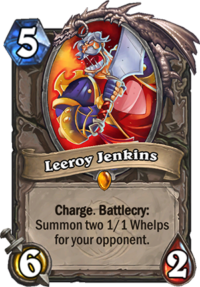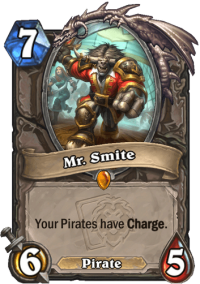There are now more cards with Charge in the Standard format than there have been in years. This is not so much because of Whizbang’s Workshop, which only includes the adorable King Plush, but more because of the Core set, which has seen the return of Leeroy Jenkins, Southsea Deckhand, and Doomguard.
Once upon a time, these cards were the terror of the ladder, but they are now ten years old. Are they still that scary? Are they even competitive anymore? Let’s take a look at the history of Charge in Hearthstone, the current power of these returned Charge minions in the meta, and whether something should be done about it.
The History of Charge in Hearthstone
Charge, the ability for a minion to immediately attack, and to attack face, is an incredibly powerful mechanic in Hearthstone. In some other card games, the defender chooses the targets, but in Hearthstone, it is the attacker who gets to choose the targets. When you combine this game mechanic with the ability to immediately attack, you get a powerful finisher.
The most iconic Charge minion of all time is Leeroy Jenkins. Leeroy has been in the game since the very beginning. Leeroy’s original cost was a mere 4 mana, but it was nerfed already in 2014, with this equally iconic developer comment:
“Leeroy Jenkins created a strategy that revolved around trying to defeat your opponent in one turn without requiring any cards on the board. We like having a variety of deck types but taking 20+ damage in one turn is not very fun or interactive.”

Leeroy stayed in the game in this slightly weaker form all the way until 2020, when it was moved to the Hall of Fame. Even at five-mana, Leeroy was a strong card. For example, in the very last major tournament where Leeroy was legal, Masters Tour Los Angeles 2020, every player in the top 8 had Leeroy in at least one of their decks, and some players even had Leeroy in three different decks!
Doomguard is only slightly less iconic than Leeroy. A key card in many Warlock decks from Zoo to Cubelock, Doomguard managed to avoid nerfs despite its strong performance, but it was eventually moved to the Hall of Fame in 2019.
Southsea Deckhand outlived both Leeroy and Doomguard in the Standard format, only leaving the format with the introduction of the Core set in 2021.
The developers realized the power of Charge early on. Half of all Charge cards printed in the entire history of Hearthstone are from the original Classic set! In addition to Leeroy, Southsea Deckhand, and Doomguard, the Classic set also included King Krush, Unleash the Hounds, Tundra Rhino, Al'Akir the Windlord, Warsong Commander, Kor'kron Elite, Grommash Hellscream, Stonetusk Boar, Bluegill Warrior, Arcane Golem, Wolfrider, Old Murk-Eye, and Argent Commander – all of which saw play in meta decks!
More recent Charge cards have often been difficult to make good use of and required significant build-around to shine, in practice eliminating them from the top ladder decks. Cage Head, for example, requires a good way to proc the Deathrattle of an eight-cost card to make use of the Charge minion. Death Beetle only gains Charge when you have at least 11 Mana Crystals. Freebird has to be copied or bounced to make it a major threat.

Whenever there has been a Charge card that is not overly complicated to use, it has become part of a meta deck. Kayn Sunfury saw play in the early days of Demon Hunter and is back again in the current Tempo Demon Hunter. Crazed Wretch was used to great effect in Enrage Warrior. Captain Galvangar was a major finisher in Control Warrior. Mr. Smite… Oh boy, what can I even say about Mr. Smite. Introduced in the Deadmines mini-set of United in Stormwind in 2021, Mr. Smite won countless games in one of the most powerful eras of Hearthstone before (and sometimes even after) getting nerfed.
The evidence about the sheer power of Charge as a mechanic is overwhelming. Leeroy was nerfed because of that power already in 2014, and the developers have been careful about printing non-gimmicky Charge cards ever since. Rush was introduced in 2018 to allow minions to act on the turn they are played without being able to hit face and end games on the spot. It has been a highly successful keyword even though it is just a nerfed Charge. Indeed, there are almost ten times as many Rush cards than there are Charge cards in Hearthstone.
Can Charge Cards from 10 Years Ago Still Be Strong?
Well, Whizbang’s Workshop did not introduce that many new Charge cards. It’s just King Plush, and it is a 9-cost card. Bringing back some cards from a decade ago is just a fun way to respect the history of the game with no meta implications, right? Surely, the game has grown that much more powerful by now. For most cards, that would indeed be the case, but not so with Charge.
Let’s take the popular Excavate Handbuff Paladin as an example. This is one of the best decks in the game right now:
In this archetype, Leeroy Jenkins is the best card in the deck. It is the card with the highest drawn win rate, and remarkably enough, it is also the card with the highest mulligan win rate. Yes, you want to keep Leeroy in your mulligan when playing Handbuff Paladin! That is the best way to ensure it gets those buffs and can then end the entire game.
In the faster Charge Handbuff Paladin, the same applies.
This archetype has more diverse Charge threats, and includes Southsea Deckhand in the mix. The Deckhand is a fine card, but once again, it is Leeroy that you want to keep in the mulligan and that is the best-performing card in the deck. The combination of a bigger Charge minion and Shroomscavate is just so strong.
Leeroy also makes an appearance in many other decks, from Spell Token Hunter to Tempo Demon Hunter and even some versions of Wheel Warlock.
In these decks, Leeroy is a fine contributor, but nothing out of the ordinary. It is not something you keep in your mulligan, either.
For Warlock, Wheel Warlock gets all the attention, but Doomguard has an effect, too. The strongest version of Sludge Warlock runs Doomguard as an additional finisher.
Not only that, but there is another new Aggro Warlock deck, Pain Warlock, which also includes Doomguard.
Doomguard’s performance is not on par with Leeroy from Handbuff Paladin, but it is still a solid contributor to the decks’ success.
Are the Core Set Charge Cards Too Strong?
Going through the decks where the Core set Charge cards are used, two things become obvious. First, despite being ten years old, these cards are still competitive. Second, the only case where any of them are overpowered, is in Handbuff Paladin.
Charge is a powerful mechanic, and Blizzard has been right to be wary of Charge cards. However, bringing back the iconic Charge minions from the first days of Hearthstone has not been a mistake as such. They are still competitive, which is a small miracle for such old cards, but it is only in combination with very specific tools that they become a threat to the well-being of the game. Paladin has the unique ability to buff them and give them Windfury, and it is this combination that is still too much for the game today. One of those pieces has to be taken away, but it does not have to be Charge. In fact, because these same Charge minions are used in successful but not oppressive ways in other meta decks, I would be sad if Charge is the component that Blizzard touches with the balance patch. By far the easiest target would be Windfury, meaning Shroomscavate.
Charge cards create design restrictions, as can be seen from the case of Handbuff Paladin. However, the most powerful Charge cards in the format are now in the Core set, so Blizzard can rotate them out at any time. They can easily let them stick around for the tenth anniversary while keeping an eye on synergistic cards this year, and rotate them out of Standard next year, if they want more design space. If it just did not have Windfury, I’d be happy to see LEEEROY JEEENKINS! roam the meta for a year again.













































































Leeroy is not a top performer in anything but Paladin. It’s Shroomscavate combined with Paladin’s buffs that’s the problem. It’s never been a problem card in Shaman, windfury just works way too well with Paladin as a class.
I’ve been spending the day hand buffing my Leeroy till he’s 12/8, then using shroomscavate to basically take my opponent down in one turn.
I’m at mid diamond after playing for 4 hours casually… that’s how hearthstone is suppose to work right?
If you’re having fun, that’s definitely how Hearthstone is supposed to work… for you
But what about all those bots that arent having as much fun as me? Who will be watching after them?
Sure its fun for me right now, but I was lucky to have made a paladin deck before rotation, so I had a lot of the cards already.
I cant imagine this being very newbie friendly though. If they want to win, they make Paladin, or they suffer until a patch. Once the patch comes out, the deck they made could be rendered useless…
I just cant understand how such a complete lack of set testing continues to happen to this day on Hearthstone. Players shouldnt be the beta testers for sets